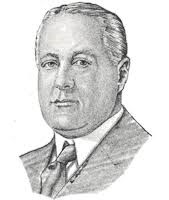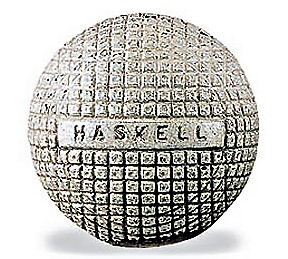People
Notable People
Coburn Haskell - Inventor of the Modern Day Golfball
11719 Lake Shore Boulevard

Coburn Haskell, an average golfer, was a member of The Country Club and frequently played golf with Bertram Work, a superintendent of the B. F. Goodrich Company, which produced the “Norka” golf ball manufactured from solid pieces of hard Malaysian gutta percha rubber. By 1899, this ball, and others similar to it, had replaced the expensive “Feathery,” a custom leather pouch stuffed with boiled feathers and stitched with a leather cover. The gutta-percha balls, nicknamed “Gutties,” didn’t fly as far as their leather counterparts but were less costly and more durable – to a degree. At a game’s end, golfers were forced to heat “Gutties” in boiling water and then squeeze them in a mold to bring them back into shape.
Legend has it that Coburn had a terrible round with one of the Norkas and was very disappointed with the ball. While sitting on the club porch, Haskell was amusing himself by winding elastic bands around a rubber ball and then bouncing it off a wall. During his little game, a light suddenly dawned. He decided to visit his friend Bertram at the B.F. Goodrich’s Akron facility. His friend was busy and suggested that Haskell might enjoy walking around the plant. While meandering about, he happened upon a pile of rubber stripping. He began to wonder if a better golf ball could be made by winding the rubber stripping around a solid rubber core.
With his friend's help, Haskell designed a prototype wound, rubber-cored ball, for which they received a patent on April 11, 1899. Haskell’s and Work’s ball was constructed by hand, winding elastic thread around a rubber core under high tension. The core was then covered with gutta-percha, later by balata and other hard rubber materials. John Gammeter invented and patented on April 11, 1899, the automatic winding machinery that allowed the rubber core ball to be economically mass-produced. This golf ball allowed players greater control after striking the ball.
The first experiments with this new rubber-containing ball were carried out at The Country Club in Bratenahl by golf professional Joe Mitchell and several of the members long before the golf balls were marketed commercially.

In 1901, Haskell retired from M. A. Hanna Company to form the Haskell Golf Ball Company, the only one in the world legally permitted to manufacture the ball. The Haskell one-piece rubber cored ball looked just like “Gutties” but gave the average golfer an extra 20 yards from the tee.
North American golfers began to take the new ball seriously when Walter Travis, originally from Australia, won the 1901 United States Amateur Championship using the Haskell ball. When Alex Herd won the 1902 British Open Championship using the Haskell ball, golfers everywhere dropped the “Gutties” and clamored for the Haskell. The new ball was called “Bounding Billy” by the British and others due to its extreme liveliness around the greens.
These early balls tended to duck and dart when hit and did not land as softly as the “Gutty.” The molded mesh pattern covers and irregularities in the winding process caused some of the problems. Also, the early versions of the Haskell ball were very lively.
The new pattern design and a thicker cover solved some of Haskell’s trajectory problems. By the early 1900s, molded mesh covers replaced pattern covers like the raised round nubs of the bramble pattern. A thicker gutta percha cover was added; this most likely helped reduce the ball's liveliness.
The Haskell Golf Ball Company made Coburn a very wealthy man. In 1917, the company dissolved, and the patents were sold to other companies, including the A. G. Spalding Company.
Coburn Haskell was born on December 31, 1868, in Boston. He moved to Cleveland in 1892 as the result of a friendship between his father and Marcus A. Hanna. Haskell became closely associated with the Hanna family and worked for the M. A. Hanna Company.
Coburn married Mary Gertrude Hanna on June 4, 1895. Mary was born in Cleveland on December 7, 1866, to Howard Melville and Kate Smith Hanna Sr. Coburn and Mary built a large brick Georgian style house at 11719 Lakeshore Boulevard, known as "Melcote." Her younger brother lived at the next house west of Melcote, and her younger sister lived in the next house east of Melcote.
Coburn and Mary had three children: Coburn Jr. was born on June 28, 1899, and died a year later on May 27, 1900, Katharine (Perkins) was born on March 19, 1903, and Gertrude (Britton) born on May 21, 1909.
Haskell was an avid duck hunter and horseman. In addition to his interest in sports, Haskell was also known as a lover of music, art, and books, owning many first editions of the early illustrators, but Coburn’s real passion was playing golf.
He belonged to The Country and Rowfant clubs, the Grolier Club of New York, and the Boston Bibliophile Society.
Cancer felled Haskell on December 14, 1922, at age 54. Mary Gertrude died on March 10, 1945, and was buried alongside Coburn at Lake View Cemetery. The appraisal of the estate was valued at $7,624,313. The federal estate tax amounted to $3,400,000. The deputy auditor stated that this was probably the most significant tax determination ever made in Cuyahoga County. Bratenahl received an inheritance tax of $346,529, roughly three times its annual operating cost.
